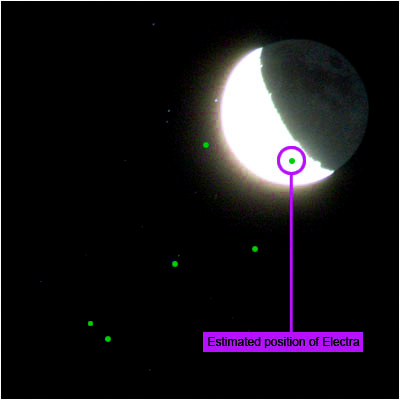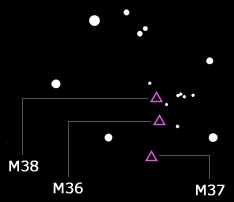
Open Clusters M36, M37 and M38

The clusters have radically different ages and so their stellar
populations have evolved to different life stages.
M37 was described by C E Barns as "A diamond sunburst". M37 is the
oldest of the 3 clusters and has had enough time to generate at least a
dozen red giant stars. Burnham gives the diameter of the cluster as around
25 light years.
M38 contains several yellow giants. Burnham gives the diameter of the
cluster as around 25 light years.
M36 as the youngest cluster contains hot white stars and no red giants,
these latter stars have not had time to evolve yet. Burnham gives the
diameter of the cluster as around 14 light years.
Open Cluster M41 - "Splendid open cluster .... easily visible with the naked eye and is resolvable with x20 binoculars" - Patrick Moore
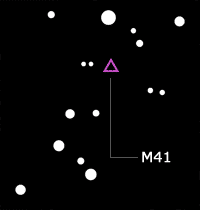
Rosette Cluster NGC 2244 - See Orion map below. A rectangular cluster of six stars in the middle of the famous Rosette Nebula. On long exposure photographs you can see that the cluster both illuminates the nebula, and has blown a hole in the middle of it which has allowed astronomers to calculate how long the stars have been shining (around half a million years). I've never seen the nebula itself through binoculars, but Crossen states "the nebula (except for its central hole) is not that difficult to see. In 10x50s averted vision is barely necessary and the nebula is even visible in 40mm zooms at about 16x" .
"I have never beheld the first indications of the rising of Orion without a peculiar feeling of awakened expectation ..." Garrett Serviss in "Astronomy with an Opera-glass", 1896
According to the BBC website (21.01.2003) scientists at the University of Munich had discovered a diagram of the constellation scratched into a prehistoric ivory tablet between 32,500 and 38,000 years old
The bright white stars in Orion have been born out of the same massive cloud of gas. Crossen points out that this Orion complex of bright stars is over 1,000 light-years deep, for its nearest bright star, Rigel, is about 900 light-years away from us and its farthest, Kappa, is around 2,100 light years distant. The complex is over 700 light years wide (the distance from Kappa on the south to Lambda in the north). Bellatrix and Betelgeuse which are not members of this complex, they are more local foreground stars only around 500 light years away from the earth.!
Betelgeuse - Red supergiant star. If placed in the middle of our solar system (at its largest size) Betelgeuse would extend as far as Jupiter! Because Betelgeuse has a mass 20x that of our sun, but extends to cover a dramatically larger volume, its average density is 10,000 times less than the air we breathe.
Orion's Belt - As well as being one of the most intensely beautiful binocular clusters in the sky ("an icy glare" according to Craig Crossen), the Belt stars were deeply inspirational for our ancestors. In locations and times as far apart as neolithic Yorkshire (Thornborough Rings) and bronze age Egypt (Giza Pyramids), humanity has attempted to model and venerate the three main belt stars on a grand scale.
Great Nebula In Orion (M42) - Beautiful and intriguing stellar nursery, surprisingly bright but ghostly in binoculars. With averted vision there is a strong sense of structure in the nebula.
Carbon Star W Orionis - According to Jim Kaler (on his Stars website) W is one of the few naked eye carbon stars in the sky. Carbon stars dredge "carbon that they have made in their nuclear-burning interiors to the surface. The carbon forms molecules that block blue light, making carbon stars among the reddest of the sky .... (W's) internally manufactured carbon will add to the carbon content of interstellar space, where it will someday find its way into other stars and perhaps other earths."
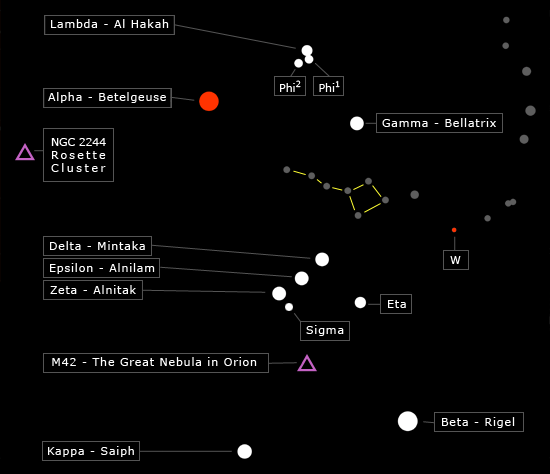
Hyades - Leading star Aldebaran is not a true member of the more distant cluster, lying approximately halfway between the earth and the Hyades. The main V pattern, commonly interpreted as representing the head of a bull with Aldebaran as its eye, has a diameter of around 9 light years.
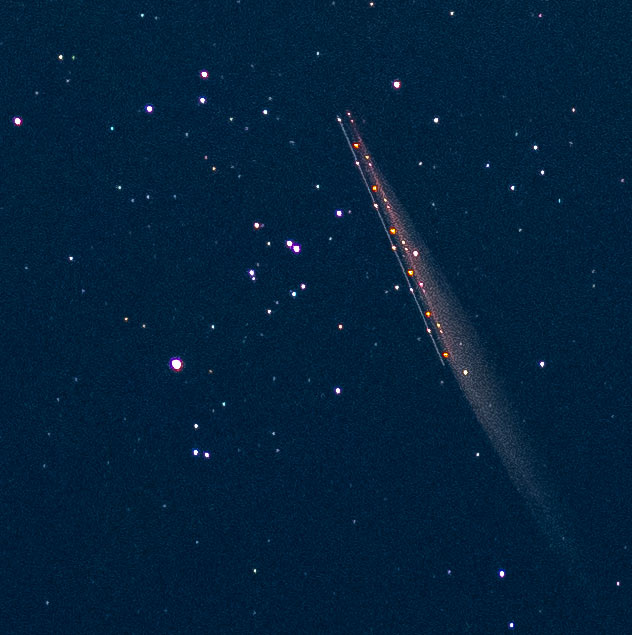
The bull's head may well be represented as an aerial image framed in the negative space between standing stones at Stonehenge, and it has been suggested that the building of the monument may have coincided with a surge in the activity of the Taurid meteor shower in Neolithic times.

It has also been suggested that as the Hyades stars have very similar sizes, spectral type, space motion and direction of travel as the stars of the Praesepe cluster in Cancer (M44), both clusters may well have been born from the same enormous cloud of interstellar gas 700 million years ago.
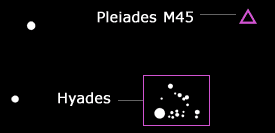
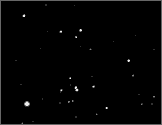
Pleiades - "Light from the time of Shakespeare". The beautiful main dipper asterism of the Pleiades is roughly 7 light years across, and so the apparent difference in size between the cluster and the Hyades is largely due to the former being 3x farther away from us.

Above: Photograph of Pleiades taken on the evening of the 10th October 2022
Below: Photographic chart showing Pleiades and the moon early on the morning of the 7th August 2007
